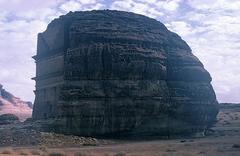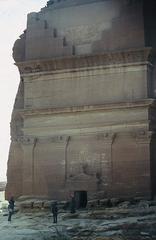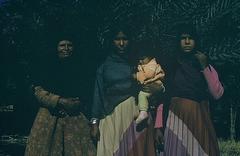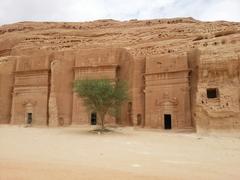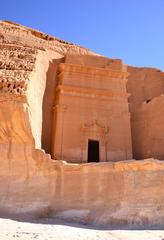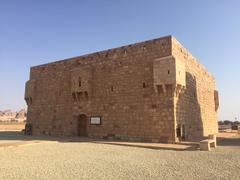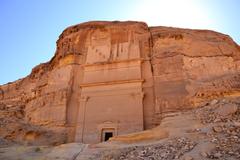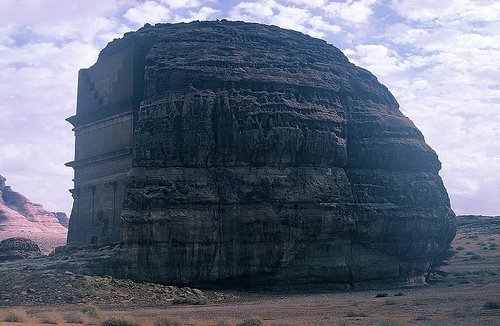
Qasr Al-Farid Visiting Hours, Tickets, and Historical Significance in Medina Province
Date: 14/06/2025
Introduction
Qasr Al-Farid, or “The Lonely Castle,” is a breathtaking Nabataean tomb carved from a single sandstone outcrop in the Hegra archaeological site (Mada’in Salih), Medina Province, Saudi Arabia. As the largest and most iconic tomb at Hegra, Qasr Al-Farid stands as a testament to the architectural mastery, cultural sophistication, and multicultural heritage of the Nabataean civilization. Designated as part of Saudi Arabia’s first UNESCO World Heritage Site in 2008, Qasr Al-Farid captivates visitors with its imposing, unfinished façade and its rich archaeological context. This detailed guide provides historical insights, practical visitor information—including visiting hours, ticketing, accessibility, and nearby attractions—and essential tips for maximizing your experience at one of the Middle East’s most remarkable heritage sites (Atlas Obscura; Smithsonian Magazine; Ecksplorer).
Historical Background
Nabataean Origins and Hegra’s Importance
The Nabataeans, an Arabic-speaking people, flourished between the 2nd century BCE and 1st century CE, dominating trade routes across the Arabian Peninsula. Petra in Jordan is their most famous capital, but Hegra (Al-Hijr or Mada’in Salih) in Saudi Arabia was their southern stronghold and a crucial stop on the Incense Route (Archaeology.org). Hegra thrived as a center of commerce and cultural exchange, a legacy reflected in its extensive archaeological remains.
Construction and Features of Qasr Al-Farid
Dating to the 1st century CE, Qasr Al-Farid is the largest tomb at Hegra, standing nearly 22 meters tall. Its grandeur and isolated position set it apart from over 100 other tombs in the area. The four-story façade is characterized by four pilasters and intricate upper decorations, while the unfinished lower section reveals chisel marks and provides rare insights into Nabataean stone-carving techniques. The monument’s scale and elaborate design indicate it was intended for a high-status individual, possibly Hayyan bin Koza (saudi-archaeology.com; ancient-origins.net).
Inscriptions and Cultural Fusion
Qasr Al-Farid’s façade features inscriptions in Nabataean, Lihyanite, and Thamudic scripts, reflecting AlUla’s role as a crossroads of civilizations. Decorative motifs such as eagles and urns symbolize protection and the afterlife, underscoring the multicultural influences that shaped Nabataean art and beliefs (smithsonianmag.com).
Hegra’s Archaeological Landscape
Hegra is home to over 100 rock-cut tombs, ceremonial chambers, and inscriptions. Key sites include the Diwan at Jabal Ithlib (a ceremonial chamber), the Siq (a narrow passage resembling Petra’s entrance), and clusters of tombs like Qasr Al-Bint and Al-Khuraymat. These monuments showcase the Nabataeans’ sophisticated blend of local and foreign architectural styles (Academia.edu).
UNESCO World Heritage Status
In 2008, Hegra became Saudi Arabia’s first UNESCO World Heritage Site, recognized for its outstanding preservation and historical significance. The Royal Commission for AlUla now oversees its conservation and visitor management (UNESCO; Royal Commission for AlUla).
Visitor Information
Location and Access
Qasr Al-Farid is situated within the Hegra archaeological area, about 22 km from AlUla city in the Medina Province. The nearest gateway is AlUla International Airport, which offers direct flights from Riyadh, Jeddah, Dammam, and Dubai (Matador Network). The drive from AlUla city to Hegra takes approximately 35 minutes along well-marked roads.
Suggested visual: Map showing Qasr Al-Farid’s location relative to AlUla and the airport; alt text: “Map of Qasr Al-Farid and AlUla historical sites in Saudi Arabia”.
Visiting Hours
- General Hours: Open daily from 8:00 AM to 6:00 PM, with seasonal variations.
- Seasonal Tips: October to March offers the most comfortable climate (15°C–28°C), ideal for exploration and photography.
Tickets and Entry
- Advance Booking: All visits require advance ticket purchase, as access is only through guided tours to protect the site.
- Where to Buy: Tickets can be purchased online via the Experience AlUla website or the official ticketing portal.
- Pricing: Standard guided tours are typically around 85 SAR (about $23 USD). Discounts may apply for children, seniors, and groups.
- Entry Requirements: Present valid ID and booking confirmation at the Winter Park Information Center in AlUla.
Guided Tours and Site Navigation
- Mandatory Guided Tours: Visitor access to Hegra, including Qasr Al-Farid, is only permitted through organized guided tours in Arabic or English. Tours last around two hours, covering main attractions such as the Hijaz Railway Station, Jabal Ithlib (Diwan), the Siq, and Qasr Al-Farid (Ecksplorer).
- Specialty Tours: Options include vintage Land Rover excursions, night tours, stargazing, and helicopter rides (available through authorized operators).
Accessibility and Visitor Facilities
- Accessibility: While the main viewing areas are accessible via designated paths, the site’s sandy and uneven terrain presents challenges for wheelchair users. Contact tour operators for accessibility arrangements.
- Facilities: Restrooms, shaded seating, water, and refreshments are available at Winter Park and Hijaz Railway Station. Visitors should bring sun protection, water, and comfortable footwear (Memphis Tours).
Visitor Experience and Recommendations
What to Expect
- Exterior Viewing: Entry into Qasr Al-Farid’s interior is prohibited for preservation reasons, but visitors can approach and photograph the exterior.
- Photography: Personal photography is encouraged. Drone use requires official permits. Commercial filming needs advance approval (Memphis Tours).
- Best Times for Photos: Sunrise and sunset provide stunning lighting on the tomb’s façade.
Additional Attractions in AlUla
- Jabal Ithlib (Diwan): A cliff-carved ceremonial chamber with inscriptions (Ecksplorer).
- The Siq: A narrow passage leading to ceremonial areas, reminiscent of Petra.
- Qasr Al-Bint and Al-Khuraymat: Tomb clusters with elaborate carvings.
- Jabal Al-Fil (Elephant Rock): A natural sandstone formation, perfect for sunset views.
- Dadan and Jabal Ikmah: Sites with ancient inscriptions and early civilization ruins (What a Wonderful World Guide).
- AlUla Old Town: Explore mud-brick houses, traditional markets, and cultural festivities.
Cultural Etiquette
- Dress Code: Modest attire is required; shoulders and knees must be covered for both men and women.
- Respect for Heritage: Littering, graffiti, or removing artifacts is strictly prohibited and penalized.
- Religious Observances: Some areas may close or have limited access during religious holidays or prayer times.
Preservation Efforts
Visitor impact is carefully managed with daily caps on numbers and strict preservation guidelines to protect delicate sandstone structures. Sustainable tourism practices ensure the site remains accessible for future generations (Memphis Tours).
Frequently Asked Questions (FAQ)
Q: What are Qasr Al-Farid’s visiting hours?
A: The site is open daily, generally from 8:00 AM to 6:00 PM, but hours may vary seasonally. Check the Experience AlUla website for current information.
Q: Are tickets required?
A: Yes, all visitors must purchase tickets in advance and join a guided tour.
Q: Is the site accessible for wheelchair users?
A: Main viewing areas are accessible via designated paths, but terrain may be challenging; consult your tour provider in advance.
Q: Can I enter the tomb?
A: No, entry into the tombs is not permitted to protect the monument.
Q: Is photography allowed?
A: Yes, but drone use and commercial filming require permits.
Q: Are non-Muslims allowed to visit?
A: Yes, Qasr Al-Farid and Hegra are open to all visitors.
Q: What is the best time to visit?
A: October to March offers comfortable temperatures and coincides with cultural events.
Visuals and Media
Insert high-quality images of Qasr Al-Farid’s façade, panoramic views of Hegra, and a location map. Use descriptive alt tags such as “Qasr Al-Farid tomb exterior in AlUla, Saudi Arabia.” Virtual tour links or videos are available on official tourism portals.
Related Articles and Further Reading
External Links:
- Royal Commission for AlUla Official Site
- UNESCO World Heritage Listing - Hegra
- Official Ticketing Portal for Hegra
Summary and Recommendations
Qasr Al-Farid exemplifies the Nabataean civilization’s ingenuity, blending architectural grandeur with a rich tapestry of cultural influences. Its solitary majesty and unfinished façade offer a unique insight into ancient traditions and the region’s dynamic history. Visiting Qasr Al-Farid is a curated experience, requiring advance booking and guided tours that both educate and preserve. The optimal visiting period is October through April, when you can also enjoy nearby attractions and cultural festivals.
By adhering to cultural etiquette and preservation guidelines, visitors play a vital role in safeguarding this irreplaceable heritage. For the latest visiting hours, ticket information, and special events, consult the official Experience AlUla portal and consider downloading the Audiala app for exclusive resources.
Qasr Al-Farid is not only a cornerstone of Saudi Arabia’s history but also a must-see destination for those seeking a deeper connection to the region’s ancient legacy (Atlas Obscura; Smithsonian Magazine; Memphis Tours; Ecksplorer; Ancient Origins; AlUla Saudi Arabia).
Sources and Further Reading
- Atlas Obscura: Qasr Al-Farid Visiting Hours, Tickets, and History
- Smithsonian Magazine: Hegra, Ancient City in Saudi Arabia
- Memphis Tours: Qasr Al-Farid Visiting Hours, Tickets & Guide
- Ecksplorer: Qasr Al-Farid and Hegra Travel Guide
- Royal Commission for AlUla Official Site
- UNESCO World Heritage Listing - Hegra
- Official Ticketing Portal for Hegra
- Ancient Origins - Qasr Al-Farid Lonely Castle of the Nabataeans
- AlUla Saudi Arabia Travel Guide
